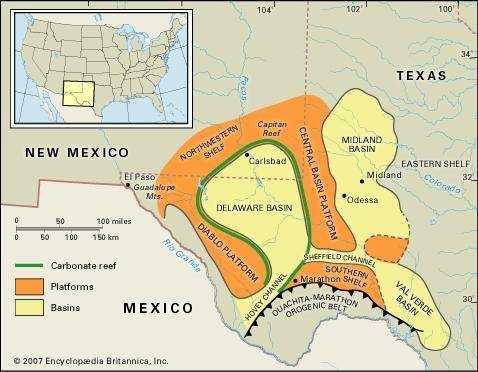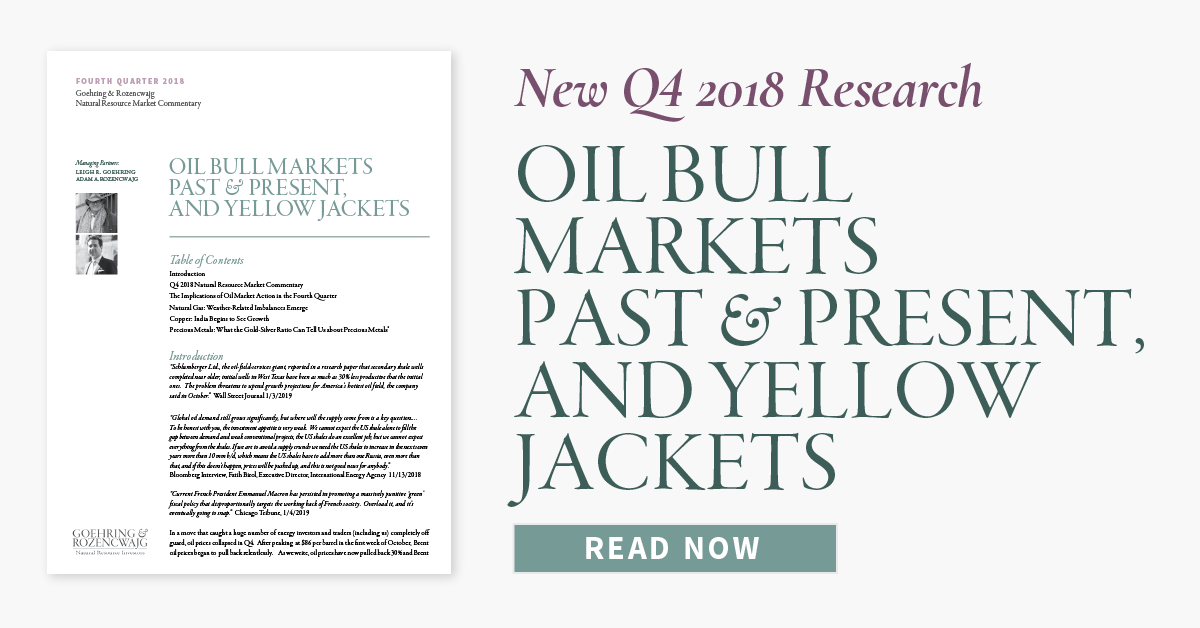"If we are correct, this would take OECD Inventory levels to 4.2 bn bbl by the end of 2019 or 90 mm bbl below the ten-year average level – a record deficit.”
Data around drilling productivity in the Permian basin continues to be very interesting. We have long argued that the Permian would continue to grow materially over the next several years, but that this growth would be needed to balance strong demand and meet disappointments in conventional non-OPEC production. The relatively benign level of inventory builds throughout 2018 despite stronger-than-expected Permian growth increases our faith in this conviction.
The Permian Basin in Western Texas

Image Source: Britannica.com
However, we think we could be seeing the first signs of field exhaustion on the Midland (Eastern) side of the Permian. For example, between 2013 and 2017, productivity per lateral foot in the Permian grew materially by 20% compounded per year. In 2018 this growth slowed to 3%. Moreover, comments from oil field service leader Schlumberger during their third quarter conference call alluded to disappointing results in so-called “child wells” in the Permian. “Parent” wells refer to the first well drilled on a pad in a virgin section of land, while “child” wells simply refer to the subsequent wells drilled. The fact that the child wells were experiencing performance degradation of as much as 30% compared with the parent wells suggests that the wells are “communicating” with each other, which is a sign that a field is progressing into its middle-life phase of development. During the quarter, Bradley Olsen of The Wall Street Journal published an article indicating that many E&P companies were overstating their well results in their corporate presentations. While both of these comments are anecdotal, we think they drive home the point that the shales, while incredibly impressive, are ultimately finite in nature and will suffer exhaustion much the same as any other hydrocarbon resource.
OIL MARKET OUTLOOK
Looking forward, we believe the oil market will once again slip into structural deficit and inventories will decline materially as we progress through the year. In their latest report, the IEA predicts 2019 year-on-year global oil demand growth of 1.4 mm b/d, raising demand to 100.6 mm b/d. As we discussed in a recent blog, Oil Updates: Brazil, Canada and Missing Barrels, our missing barrel analysis continues to point to forthcoming upward revision to 2018 demand of as much as 500,000 mm b/d. We believe these missing barrels are actually demand underestimation, and we expect this underestimation of demand to continue into 2019.
As a result, we believe global demand projections for 2019 are understated by 500,000 b/d and will ultimately reach 101.1 mm b/d – not 100.6 mm b/d as predicted by the IEA. Please remember that the IEA has now revised its demand projections higher in seven of the last eight years by 1.2 mm b/d on average. We don’t expect 2019 to be different. While concerns about trade wars and economic slowdowns are widespread, we should point out we have seen no impact to-date in global oil demand figures. Non-OPEC production outside of the US and Russia, according to the IEA, is expected to reverse course and grow by 120,000 b/d in 2019—a number we believe is simply not possible.
Instead, given the severe recent weakness in this group, we believe this number may actually decline by 300,000 b/d in 2019 to reach 40.1mm b/d. Russia has announced they will curtail production by 400,000 b/d from their November levels, resulting in full-year production of 11.4 mm b/d for 2019. The IEA is projecting US production to grow by 1.3 mm b/d in 2019 and here our models actually suggest growth may be understated. Assuming the US is able to grow by 1.5 mm b/d on a year-on-year basis, production would average 16.9 mm b/d in 2019. Adding in biofuels, refining gains, and OPEC NGLs, we expect total non-OPEC production in 2019 to average 68.4 mm b/d.
Given demand of 101.1 mm b/d this implies a call-on-OPEC of 32.7 mm b/d. At their November meeting, the cartel agreed to a cut of 800,000 b/d that would leave 2019 OPEC production at 32.2 mm b/d, suggesting an oil market deficit of 500,000 mm b/d for 2019. If we are correct, this would take OECD inventory levels to 4.2 bn bbl by the end of 2019 or 90 mm bbl below the ten-year average level – a record deficit. While OPEC may increase quotas at their April 2019 meeting, our models tell us this will in fact be necessary to avoid a drastic decline in global oil inventory levels and a spike in prices.
This blog contains excerpts of our in-depth commentary “OIL BULL MARKETS PAST & PRESENT, AND YELLOW JACKETS”. If you are interested in this subject, we encourage you to download the full commentary here.


